check engine CITROEN RELAY 2017 Handbook (in English)
[x] Cancel search | Manufacturer: CITROEN, Model Year: 2017, Model line: RELAY, Model: CITROEN RELAY 2017Pages: 292, PDF Size: 9.04 MB
Page 120 of 292

118
cAB SEAt BELt S
If you install a front bench seat as
an accessory, it it must be fitted with
approved seat belts.
Fastening
Pull the strap in front of you with an even
movement, ensuring that it does not twist.
Engage the tongue in its buckle.
Check that the seat belt is fastened securely
and that the automatic locking system is
operating correctly by pulling the strap
rapidly.
unfastening
Press the red button on the buckle, the
seat belt reels in automatically but you are
advised to guide it.
As a safety measure, these operations
should not be carried out while the
vehicle is moving.
Seat belts not fastened
warning lamp
If the driver's seat belt is unfastened,
START mode of Stop & Start will not be
invoked. Engine restarting is only possible
with the ignition key. When the vehicle is started, this warning
lamp comes on, accompanied by an
increasing audible signal, if the driver and/
or the front passenger has not fastened their
seat belt.
The alert operates both for versions with
an individual passenger front seat and for
versions with a 2-seat front bench seat.
The driver's seat is fitted with a pyrotechnic
pretensioner and a force limiter.
On versions with a passenger's front airbag,
the passenger's seat is also fitted with a
pyrotechnic pretensioner and a force limiter.
The front bench seat is fitted with two seat
belts.
Height adjustment
For the driver or outer passenger seat,
squeeze the control at the adjustable top
mounting, slide the assembly, then release
at the desired position to lock it.
The height of the seat belt for the centre
seat cannot be adjusted.
Seat belts
Page 125 of 292

123
deactivating the passenger's front
airbag
When OFF is selected, the passenger's front
airbag will not be triggered in the event of an
impact.
As soon as the child seat is removed,
select
ON to re-activate the airbag and thus
ensure the safety of your front passengers in
the event of an impact.Lateral airbags and curtain airbags
If your vehicle is fitted with lateral airbags,
these are fitted to the front seat backs on
the door side.
The curtain airbags are fitted to the door
pillars and the upper part of the passenger
compartment, in the roof over the front cab
seats.
They inflate between the occupant and the
glazed area.
They are deployed independently of each
other depending on which side the collision
occurs.
To ensure the safety of your child, it is
essential to deactivate the passenger's
front airbag when you install a rearward
facing child seat on the front passenger
seat. Otherwise, the child would risk being
killed or seriously injured if the airbag were
to inflate.
If your vehicle's front passenger airbag
cannot be deactivated: you must not install a
rearward facing child seat.
d
eactivation check
This is confirmed by the
illumination of this warning lamp,
accompanied by a message in
the display screen, every time the
engine is started.
Operating faultIf this warning lamp comes on,
contact a CITROËN dealer to
have the vehicle checked.
Refer to the "Technology on board -
Vehicle configuration" section.
The setting is made using the "MO
d
E"
button: in the "Passenger airbag" menu,
select "OFF".
5
SAFEtY
Airbags
Page 136 of 292
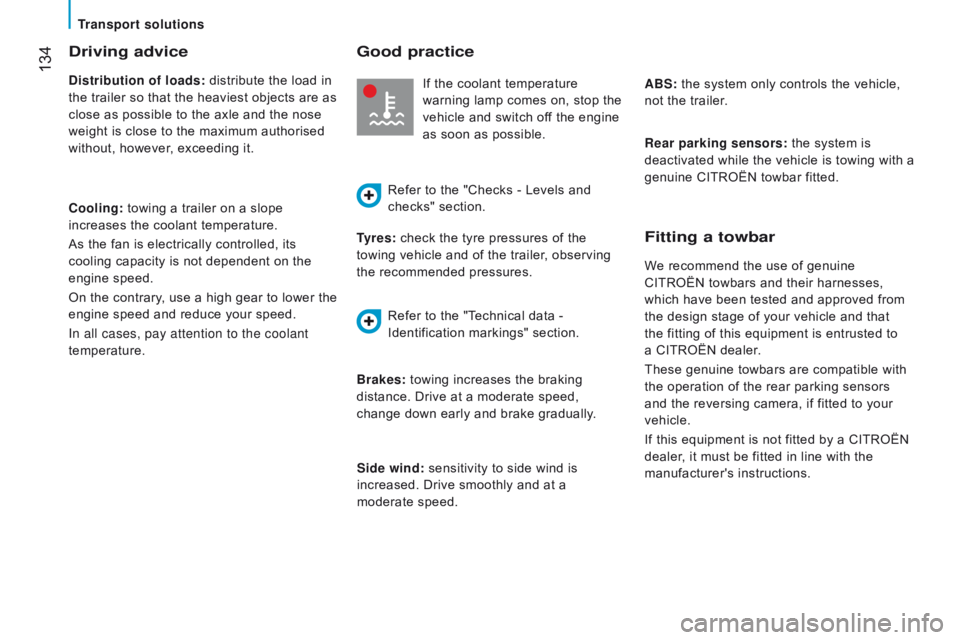
134
driving advice
distribution of loads: distribute the load in
the trailer so that the heaviest objects are as
close as possible to the axle and the nose
weight is close to the maximum authorised
without, however, exceeding it.
c
ooling: towing a trailer on a slope
increases the coolant temperature.
As the fan is electrically controlled, its
cooling capacity is not dependent on the
engine speed.
On the contrary, use a high gear to lower the
engine speed and reduce your speed.
In all cases, pay attention to the coolant
temperature.
tyres:
check the tyre pressures of the
towing vehicle and of the trailer, observing
the recommended pressures.
Fitting a towbar
We recommend the use of genuine
CITROËN towbars and their harnesses,
which have been tested and approved from
the design stage of your vehicle and that
the fitting of this equipment is entrusted to
a
CITROËN dealer.
These genuine towbars are compatible with
the operation of the rear parking sensors
and the reversing camera, if fitted to your
vehicle.
If this equipment is not fitted by a CITROËN
dealer, it must be fitted in line with the
manufacturer's instructions.
Good practice
If the coolant temperature
warning lamp comes on, stop the
vehicle and switch off the engine
as soon as possible.
Refer to the "Checks - Levels and
checks" section.
Brakes: towing increases the braking
distance. Drive at a moderate speed,
change down early and brake gradually. Side wind: sensitivity to side wind is
increased. Drive smoothly and at a
moderate speed. ABS: the system only controls the vehicle,
not the trailer.
r
ear parking sensors: the system is
deactivated while the vehicle is towing with a
genuine CITROËN towbar fitted.
Refer to the "Technical data -
Identification markings" section.
transport solutions
Page 141 of 292

139
On the inside
This operation must only be carried out with the
vehicle stationary and the driver's door open.
Pull the release lever on the side of the
dashboard towards you.
On the outside
Raise the safety catch lever located above
the grille to the right and raise the bonnet.Before closing the bonnet, put the stay back
in its housing.
Lower the bonnet and release it at the end
of its travel. Check that the bonnet has
latched.
OPEnInG tHE BOnnEt
Do not open the bonnet in strong
winds.
When the engine is hot, handle the safety
catch and stay with care (risk of burns).
Before doing anything under the
bonnet, switch off the ignition with the
key to avoid any risk of injury resulting from
an automatic change to START mode of the
Stop & Start system.
cLOSInG tHE BOnnEt
Bonnet stay
Unclip the stay and tilt it to insert it in the
first notch, then the second.
Because of the presence of electrical
equipment under the bonnet, it is
recommended that exposure to water (rain,
washing, ...) be limited.
7
under the bonnet
cHEcKS
Page 143 of 292
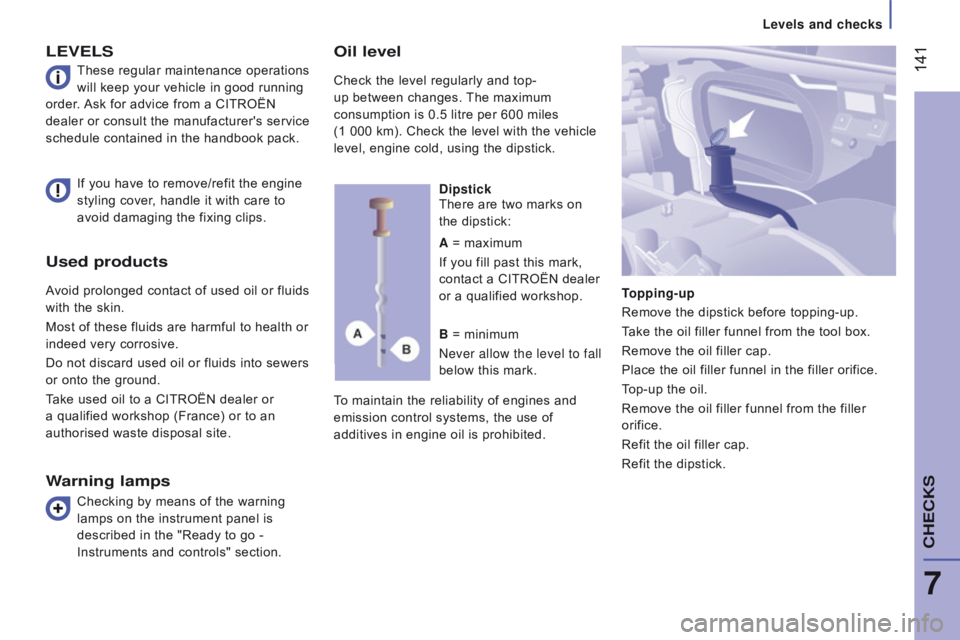
141
used products
Avoid prolonged contact of used oil or fluids
with the skin.
Most of these fluids are harmful to health or
indeed very corrosive.
Do not discard used oil or fluids into sewers
or onto the ground.
Take used oil to a CITROËN dealer or
a qualified workshop (France) or to an
authorised waste disposal site.
LEVELS
To maintain the reliability of engines and
emission control systems, the use of
additives in engine oil is prohibited.
If you have to remove/refit the engine
styling cover, handle it with care to
avoid damaging the fixing clips.
d
ipstick
There are two marks on
the dipstick:
topping-up
Remove the dipstick before topping-up.
T
ake the oil filler funnel from the tool box.
Remove the oil filler cap.
Place the oil filler funnel in the filler orifice.
Top-up the oil.
Remove the oil filler funnel from the filler
orifice.
Refit the oil filler cap.
Refit the dipstick.
A
= maximum
If you fill past this mark,
contact a CITROËN dealer
or a qualified workshop.
B = minimum
Never allow the level to fall
below this mark.
Warning lamps
These regular maintenance operations
will keep your vehicle in good running
order. Ask for advice from a CITROËN
dealer or consult the manufacturer's service
schedule contained in the handbook pack.
Checking by means of the warning
lamps on the instrument panel is
described in the "Ready to go -
Instruments and controls" section.
Oil level
Check the level regularly and top-
up between changes. The maximum
consumption is 0.5 litre per 600 miles
(1 000 km). Check the level with the vehicle
level, engine cold, using the dipstick.
7
cHEcKS
Levels and checks
Page 144 of 292
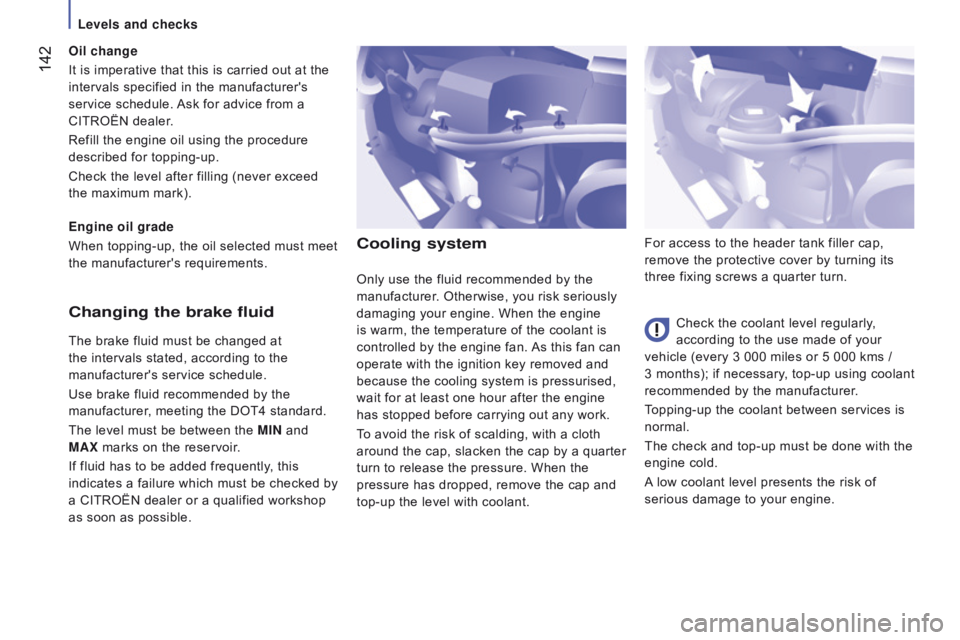
142
cooling system
Check the coolant level regularly,
according to the use made of your
vehicle (every 3 000 miles or 5 000 kms
/
3
months);
if necessary, top-up using coolant
recommended by the manufacturer.
Topping-up the coolant between services is
normal.
The check and top-up must be done with the
engine cold.
A low coolant level presents the risk of
serious damage to your engine. For access to the header tank filler cap,
remove the protective cover by turning its
three fixing screws a quarter turn.
Only use the fluid recommended by the
manufacturer. Otherwise, you risk seriously
damaging your engine. When the engine
is warm, the temperature of the coolant is
controlled by the engine fan. As this fan can
operate with the ignition key removed and
because the cooling system is pressurised,
wait for at least one hour after the engine
has stopped before carrying out any work.
To avoid the risk of scalding, with a cloth
around the cap, slacken the cap by a quarter
turn to release the pressure. When the
pressure has dropped, remove the cap and
top-up the level with coolant.changing the brake fluid
The brake fluid must be changed at
the intervals stated, according to the
manufacturer's service schedule.
Use brake fluid recommended by the
manufacturer, meeting the DOT4 standard.
The level must be between the MI
n and
MA
x marks on the reservoir.
If fluid has to be added frequently, this
indicates a failure which must be checked by
a CITROËN dealer or a qualified workshop
as soon as possible. Engine oil grade
When topping-up, the oil selected must meet
the manufacturer's requirements. Oil change
It is imperative that this is carried out at the
intervals specified in the manufacturer's
service schedule. Ask for advice from a
CITROËN dealer.
Refill the engine oil using the procedure
described for topping-up.
Check the level after filling (never exceed
the maximum mark).
Levels and checks
Page 145 of 292

143
topping-up
The level must be between the MI n and
MA
x marks on the expansion bottle.
As close as possible to the MA
x mark is
recommended.
If more than 1 litre of fluid is required to top-
up the level, have the system checked by a
CITROËN dealer or a qualified workshop.
Power steering fluid level
The vehicle must be parked on level ground
with the engine cold. Unscrew the cap
integrated with the gauge and check the
level which must be between the MI
n and
MA
x marks.
For access to the reservoir filler cap, remove
the protective cover by turning its three
fixing screws a quarter turn, then remove the
second cover fitted to the cap.
Windscreen wash and headlamp
wash level
Capacity of the reservoir: approximately
5.5 litres.
For access to the reservoir filler cap, pull on
the telescopic filler pipe and unclip the cap.
For best quality cleaning and to prevent
freezing, this fluid must not be topped-up or
replaced with plain water.
In wintry conditions, the use of an alcohol or
methanol based fluid is recommended.
7
cHEcKS
Levels and checks
Page 147 of 292
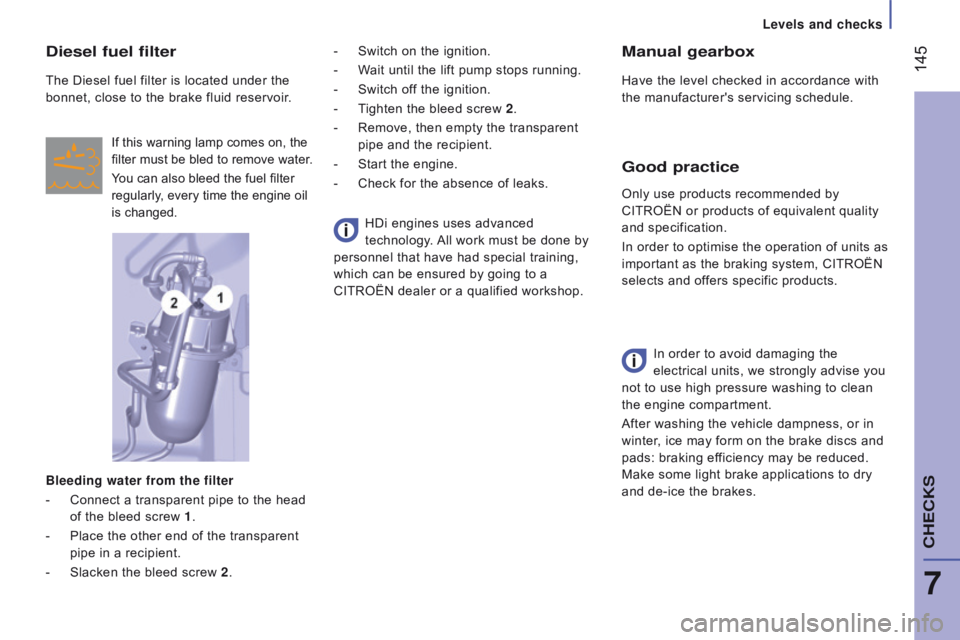
145
Manual gearbox
Have the level checked in accordance with
the manufacturer's servicing schedule.
Good practice
In order to avoid damaging the
electrical units, we strongly advise you
not to use high pressure washing to clean
the engine compartment.
After washing the vehicle dampness, or in
winter, ice may form on the brake discs and
pads: braking efficiency may be reduced.
Make some light brake applications to dry
and de-ice the brakes. Only use products recommended by
CITROËN or products of equivalent quality
and specification.
In order to optimise the operation of units as
important as the braking system, CITROËN
selects and offers specific products.
diesel fuel filter
The Diesel fuel filter is located under the
bonnet, close to the brake fluid reservoir.
If this warning lamp comes on, the
filter must be bled to remove water.
Y
ou can also bleed the fuel filter
regularly, every time the engine oil
is changed.
Bleeding water from the filter
-
Connect a transparent pipe to the head
of the bleed screw 1 .
-
Place the other end of the transparent
pipe in a recipient.
-
Slacken the bleed screw
2. HDi engines uses advanced
technology. All work must be done by
personnel that have had special training,
which can be ensured by going to a
CITROËN dealer or a qualified workshop. -
Switch on the ignition.
-
W
ait until the lift pump stops running.
-
Switch of
f the ignition.
-
T
ighten the bleed screw 2
.
-
Remove, then empty the transparent
pipe and the recipient.
-
Start the engine.
-
Check for the absence of leaks.
7
cHEcKS
Levels and checks
Page 148 of 292
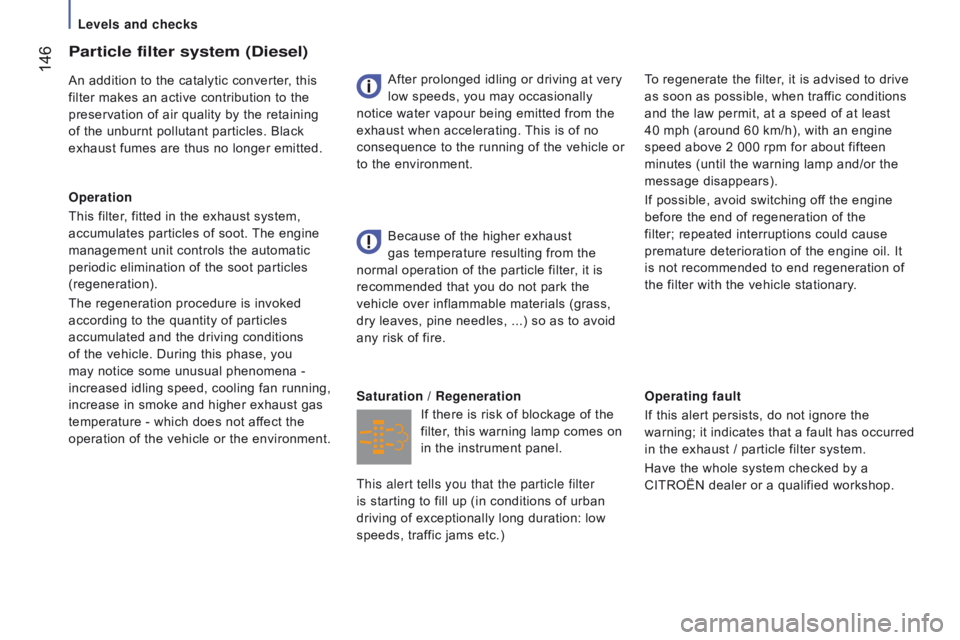
146
Operating fault
If this alert persists, do not ignore the
warning; it indicates that a fault has occurred
in the exhaust / particle filter system.
Have the whole system checked by a
CITROËN dealer or a qualified workshop.
If there is risk of blockage of the
filter, this warning lamp comes on
in the instrument panel.
Saturation /
r
egeneration
Because of the higher exhaust
gas temperature resulting from the
normal operation of the particle filter, it is
recommended that you do not park the
vehicle over inflammable materials (grass,
dry leaves, pine needles,
...) so as to avoid
any risk of fire.
Particle filter system (diesel)
An addition to the catalytic converter, this
filter makes an active contribution to the
preservation of air quality by the retaining
of the unburnt pollutant particles. Black
exhaust fumes are thus no longer emitted.
Operation
This filter, fitted in the exhaust system,
accumulates particles of soot. The engine
management unit controls the automatic
periodic elimination of the soot particles
(regeneration).
The regeneration procedure is invoked
according to the quantity of particles
accumulated and the driving conditions
of the vehicle. During this phase, you
may notice some unusual phenomena -
increased idling speed, cooling fan running,
increase in smoke and higher exhaust gas
temperature
- which does not affect the
operation of the vehicle or the environment. After prolonged idling or driving at very
low speeds, you may occasionally
notice water vapour being emitted from the
exhaust when accelerating. This is of no
consequence to the running of the vehicle or
to the environment. To regenerate the filter, it is advised to drive
as soon as possible, when traffic conditions
and the law permit, at a speed of at least
40 mph (around 60 km/h), with an engine
speed above 2 000 rpm for about fifteen
minutes (until the warning lamp and/or the
message disappears).
If possible, avoid switching off the engine
before the end of regeneration of the
filter; repeated interruptions could cause
premature deterioration of the engine oil. It
is not recommended to end regeneration of
the filter with the vehicle stationary.
This alert tells you that the particle filter
is starting to fill up (in conditions of urban
driving of exceptionally long duration: low
speeds, traffic jams etc.)
Levels and checks
Page 149 of 292

147
Low fuel level
rEF
u
ELLI
n
G
In low temperatures
In mountainous and/or cold areas, it is
advisable to use a "winter" type fuel suited
to low or minus temperatures.
With Stop & Start, never refuel with
the system in STOP mode; you must
switch off the ignition with the key. When the fuel tank level E
(Empty) is reached, this warning
lamp comes on.
You then have around 10 to
12 litres in the reserve, depending on the
capacity of the tank and the engine.
Refuel without delay to avoid running out of
fuel.
The fuel tank must be filled with the engine
off.
-
Open the fuel filler flap.
-
Support the black cap with one hand.
-
With the other hand, insert the key
, then
turn it anticlockwise.
-
Remove the black cap and hook it onto
the clip located on the inside of the flap. A label affixed to the inside of the flap
reminds you of the type of fuel to be used.
When filling the fuel tank, do not continue
after the 3rd cut-off of the nozzle. This could
cause malfunctions.
-
After filling the fuel tank, lock the black
cap and close the flap.
BlueH d i and AdBlue
The blue cap is only present on BlueHDi
Diesel versions.
For more information, refer to the "AdBlue"
section.
To understand the significance of the
precautions mentioned on the labels,
refer to the "Quick help - Label glossary"
section.
The capacity of the fuel tank is
approximately 90
litres.
Fuel tanks of different capacities may be
fitted, 60 and 120 litres, depending on the
engine.
7
cHEcKS
Fuel